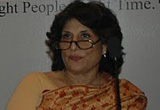 There has been an unexpected and welcome development in the public discourse on India’s malnutrition. For the first time, the subject is a talking point in the pre-election political debates, as a determinant of development.
There has been an unexpected and welcome development in the public discourse on India’s malnutrition. For the first time, the subject is a talking point in the pre-election political debates, as a determinant of development.
Other significant shifts in perception have also taken place among those working in this sector. I recently attended a consultation organized by the Centre for Health Education, Training, and Nutrition Awareness (CHETNA), a Maharashtra NGO, and the Global Alliance for Improved Nutrition (GAIN). For the first time again, I sensed unanimity among participants representing governmental and non-governmental sectors, experts and field workers, that India’s malnutrition cannot be addressed through integrated child development services (ICDS) alone, but requires something additional.
The focus has rightly shifted to the inter-sectoral approach, but it is precisely at this point that the discussion gets stuck. In the absence of a national programme with an inter-sectoral template, no one, including the government, seems to know how exactly to intervene inter-sectorally. NGOs and philanthropic institutions, genuinely keen to work in this field, find it difficult without a design or format to guide them. Strong national programmes with well-defined structure, such as the education and health sectors, provide a fulcrum for non-governmental/philanthropic organizations to provide partnership without complication. The absence of a national programme addressing malnutrition prevents such a partnership platform from existing, and results in an information void regarding what interventions are essential, and how best to undertake them. Hence, there are few NGOs in the nutrition sector, unlike in the health and education sectors, and there is not much they can contribute except feeding programmes, occasional conferences, and advocacy, mostly on isolated themes.
There are other negative cascading effects. Experience shows that public awareness and information dissemination on social and development issues is largely generated through the medium of strong national programmes, which themselves become the strongest advocacy tools reading messages down to grassroots, notably, health, education and women’s empowerment programmes. Again, in the absence of a national programme, information and awareness regarding malnutrition has no such medium. Hence, there is another information void at a grassroots level, within families, community organizations, NGO field staff and government. This is evident at critical preventive points, such as timely and adequate complementary feeding to prevent onset of child under-nutrition, maternal nutritional care to ensure adequate pregnancy weight gain and prevent low birth-weight babies, (often the first casualties to neo-natal mortality), and nutritional interventions to prevent undernourishment among adolescent girls, the future mothers.
This lack of information and awareness also results in absence of capacity creation among governmental/non-governmental stakeholders at policy and field levels, and most importantly, in an absence of demand for nutritional interventions from the afflicted population, simply because they have no knowledge or awareness regarding their affliction. Therefore, there are hardly any think tanks, research or capacity building institutions at state or district levels, no journals or information in local languages to inform rural populations, or local institutions about the subject, not even vernacular equivalents for terms like “body mass index” or “chronic energy deficiency.”
Finally, all of the above factors prevent an enabling environment for a cohesive, vocal nutrition lobby with strong leadership to influence government, as exists in other sectors. There is negligible presence of public health and nutrition in research institutions in state capitals, and none at all in district or block institutions, where the action really lies. Besides, the limited nutrition lobby does not work with a common platform, but on individual issues that often deflect attention from the urgency of addressing malnutrition holistically. A strong, cohesive nutrition lobby, providing innovation and working models could have acquired greater clout over government to announce a national programme to address malnutrition, so urgently required in the country.
To sum up a rather despondent governance environment, there is a lack of information and capacity among all stakeholders, particularly in the community, a lack of demand from the afflicted, an ostracism of the private sector, who have a corporate social responsibility mandate to address malnutrition, and the baggage of old schemes. Instead of innovation, the creaking ICDS structure is being saddled with ever more activities making no impact.
A comprehensive strategy to address malnutrition is perfectly doable. The Karnataka Nutrition Mission has piloted it, based on inter-generational, inter-sectoral interventions, bridging the dietary calorie-protein-micronutrient gap, initiating grassroots awareness programmes, and rigorous real time monitoring, with very encouraging results. Details are available at www.karnutmission.org.
Having become a political talking point in the pre-election debate, there is hope that political parties will include a strong national programme addressing malutrition in their election manifestos.
Veena S Rao is adviser, Karnataka Nutrition Mission.
